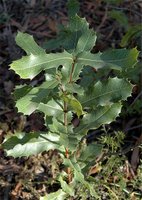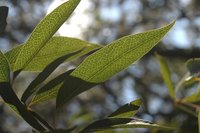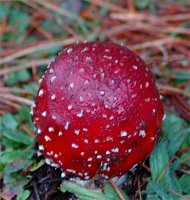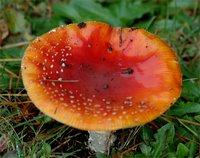
The Woody Pear is a weird plant.
It is a member of the Proteaceae family of plants - along with the better known Waratahs, Banksias, Hakeas and Grevilleas.
But it has a very different "fruit" from those plants.
Both the common and scientific names refer to its distinctive pear-shaped fruits (see left). Its specific name is Xylomelum pyriforme. The scientific name breaks down to woody fruit - with a pear shape.
But unlike a pear, they are attached at the "fat" end.

The "fruit", although pear shaped (but upside down) is a hard woody capsule.
That capsule opens along one side, to release two winged seeds. In that regard it shows its relationship to the Hakea family.
However, its fruit are much larger than those of the Hakeas.
 The leaves of Woody Pears (as juvenile plants - ONLY ) are sharply toothed along their margins.
The leaves of Woody Pears (as juvenile plants - ONLY ) are sharply toothed along their margins.
As a small plant on the forest floor, they could easily be mistaken for a juvenile Waratah, or else a member of the Lomatia genus (both of which groups are related plants, and which grow in the same areas as these plants are found).
As the plants mature, their leaves change quite dramatically.
When the plant is mature, its young leaves (new season's growth) are noticeably pinkish. However, these pinkish leaves develop a green pigment, as they mature.
 They change into this bright olive-green colour. Both these stages of leaves (the pink and the green stages) on the mature plant have lance-shaped leaves, with smooth edges. The botanists refer to them as having "entire" margins.
They change into this bright olive-green colour. Both these stages of leaves (the pink and the green stages) on the mature plant have lance-shaped leaves, with smooth edges. The botanists refer to them as having "entire" margins.
The pictures are useful to show both leaf shapes.
The texture of the leaf is distinctive, though, once one looks closely at it (have a close look at the photo above). It is heavily veined, with a strong, dominant mid vein. There is a bold net-like veining which is quite obvious, especially when viewed through from below, in good light, as in the photo above.
 These plants are far from obvious, growing amongst the heavily timbered Eucalypt forest, below Robertson, on the deeper soil areas, over the sandstone base. I would consider them to be "uncommon" in the Robertson and Kangaloon area. (They do not occur naturally on the red basalt soils of Robertson itself). Nor do they appear to favour the poorer, shallow, sandstone soils, for example along Tourist Road.
These plants are far from obvious, growing amongst the heavily timbered Eucalypt forest, below Robertson, on the deeper soil areas, over the sandstone base. I would consider them to be "uncommon" in the Robertson and Kangaloon area. (They do not occur naturally on the red basalt soils of Robertson itself). Nor do they appear to favour the poorer, shallow, sandstone soils, for example along Tourist Road.
There are good stands of these plants which may be seen on Mt Gibbergunyah, and some on Mt Alexandra. Both those mountains are in the Mittagong/Welby area.
These plants grow as a mid-storey plant (a tall shrub). In this case these Woody Pears are growing in a group, below tall Eucalypts. But in their manner of growth they resemble sapling Eucalypts.
With their long, strap-like leaves, they are easily overlooked as if they were just young Gum Trees.
According to the reference books, these plants are a "protected species". No part of these plants may be picked. Unfortunately, I have seen the "Woody Pear" fruits on sale in florist shops, for use in floral art arrangements. That practice is apparently illegal. Let us just admire them, in the bush.

 Anyway, after just a few minutes of this performance, the male had some success, for a female paddled very directly across the reservoir from the reed-bank on the far side of the reservoir.
Anyway, after just a few minutes of this performance, the male had some success, for a female paddled very directly across the reservoir from the reed-bank on the far side of the reservoir.

 If you did not know that you were looking at Musk Ducks, you could be forgiven for thinking you had seen a very small, Southern Highlands version of the Loch Ness Monster.
If you did not know that you were looking at Musk Ducks, you could be forgiven for thinking you had seen a very small, Southern Highlands version of the Loch Ness Monster.







